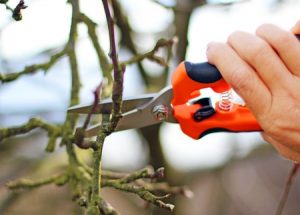Written by Landscape Hub and published on https://www.landscapehub.com/.
This is just one of the few misconceptions around the best time to prune your trees. You’re enjoying the benefits of your property during the spring and summer when growth is active, and more likely to notice any unsightly appearances caused by new spring growth. This often becomes a nuisance to homeowners. Clients also assume that trimming can’t be completed during the winter due to safety concerns of snow and ice. Arborists actually have optimal access when trees are dormant. Limbs are lighter and easier to handle, and leafless tree structures are easier to see.
Table of Contents
Benefits of Dormant Pruning for You and Your Client
Now that the leaves are falling, and temperatures are dropping, that doesn’t mean that landscaping for the year is over. From November through mid-March, plants in the midwest zones are in their dormancy period. Sap is not flowing as fast, airborne fungal diseases are not as active, and insect activity is low.
Winter is actually the best time to prune, shape, and thin many deciduous plants, trees, and shrubs. Pruning cuts heal faster during dormancy, making this a low-risk time of year to make even large cuts. Best of all, pruning during this dormant season can yield fantastic results in spring.
Why Prune?

Pruning controls the size of a tree and encourages flowering and fruiting. Pruning also keeps unwieldy or overgrown trees and shrubs healthy. Removing certain types of growth before problems arise is key, and we’ll outline those risk factors below.
For Better Development
For younger trees, proper pruning helps the tree develop a robust structure and eye-catching form. If a tree gets appropriate structural pruning when it’s young, you are less likely to end up with an overgrown tree that will need difficult, corrective fixes later.
For Safety
When there are diseased, broken, crossed, or dead branches on your trees, preventative pruning helps ensure that these branches don’t cause injury or property damage, as they tend to break off on their own, or fall under the weight of ice and snow. Crossed branches rub together and create wounds that invite infection and boring insects, which can affect the entire tree systemically, leading to loss of vitality or even death.
To Promote Growth
When you prune a tree or shrub properly, you promote healthy new growth. Pruning is also a good way to cut back fast-growing shoots, suckers, or water sprouts, which are not only unsightly, but also weak and more likely to break as they grow.
Just be careful not to overdo it. We recommend removing no more than 1/4 of a plant in a season. Stress caused by over-pruning can actually result in more suckers and water sprouts as the tree attempts to rebound.
For Air Circulation
When plants have proper air circulation it helps them remain disease free. To do this, you’ll need to thin out the branches that make up the dense mass of the plant. Without this thinning, the chance for insect damage and disease are much greater. Again, be conscientious: take a step back every few snips to see what you’ve done. Pruning too much can hollow out the plant’s center.
For a Better View
Often tree branches can get in the way of your view from your deck or windows. Vista pruning during this dormant season allows you to carefully remove the right branches to expand the view without causing harm to the tree. This ensures you keep a natural look.
Common Pruning Mistakes
Pruning is a bit of an art form and can be tricky. If you make mistakes, trees and shrubs may suffer damage. Here are some additional tips focusing on what not to do.
Don’t Snip the Tips
Snipping a little at the tips is more harmful than a making larger cuts. Pruning stimulates plant growth, so if you snip the tip of one branch, four to six new branches will take its place. Snipping those tips off will continue the cycle until you have a plant with too many branches.
“Topping”
Unless you are attempting a radical pruning technique like pollarding, you don’t want to just shear the top of a shrub. This pruning mistake is referred to as “topping.” Topping creates a new arrangement of shoots that could make the shrub unmanageable. Instead, follow the natural lines of the plant while pruning.
Leaving A Stub
Always prune back to a bud or branch instead of leaving a stub. Stubs encourage horizontal sucker growth and disease. You’ll want to prune above a bud. This will cause a new branch to grow from the bud.
Skipping Pruning During the Winter
Not pruning is perhaps the most common pruning error. Your clients need to be educated on dormant pruning, so they have healthier plants when spring comes around.
Original post here https://www.landscapehub.com/blog/benefits-of-dormant-pruning-for-you-and-your-client/.